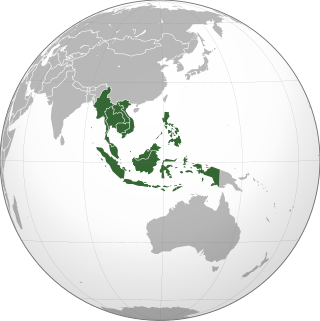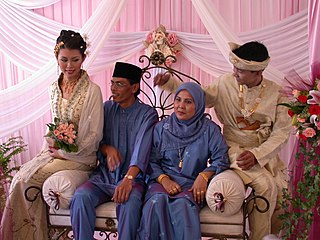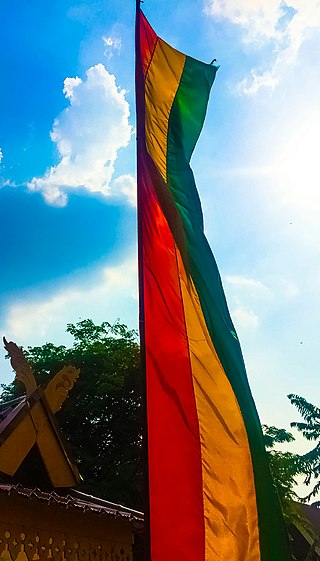Related Research Articles

Sumatra is one of the Sunda Islands of western Indonesia. It is the largest island that is fully within Indonesian territory, as well as the sixth-largest island in the world at 482,286.55 km2 (182,812 mi.2), including adjacent islands such as the Simeulue, Nias, Mentawai, Enggano, Riau Islands, Bangka Belitung and Krakatoa archipelago.

Southeast Asia is the geographical southeastern region of Asia, consisting of the regions that are situated south of China, east of the Indian subcontinent, and northwest of the Australian mainland, which is part of Oceania. Southeast Asia is bordered to the north by East Asia, to the west by South Asia and the Bay of Bengal, to the east by Oceania and the Pacific Ocean, and to the south by Australia and the Indian Ocean. Apart from the British Indian Ocean Territory and two out of 26 atolls of the Maldives in South Asia, Maritime Southeast Asia is the only other subregion of Asia that lies partly within the Southern Hemisphere. Mainland Southeast Asia is entirely in the Northern Hemisphere. East Timor and the southern portion of Indonesia are the parts of Southeast Asia that lie south of the equator.

Malays are an Austronesian ethnoreligious group native to eastern Sumatra, the Malay Peninsula and coastal Borneo, as well as the smaller islands that lie between these locations. These locations are today part of the countries of Malaysia, Indonesia, the southern part of Thailand, Singapore and Brunei Darussalam.

South Sumatra is a province of Indonesia, located in the southeast of the island of Sumatra. The capital and largest city of the province is the city of Palembang. The province borders the provinces of Jambi to the north, Bengkulu to the west and Lampung to the south, as well a maritime border with the Bangka Belitung Islands to the east. It is the largest province in the island of Sumatra, and it is slightly smaller than Portugal, the department of Boquerón in Paraguay or the U.S. state of Maine. The Bangka Strait in the east separates South Sumatra and the island of Bangka, which is part of the Bangka Belitung Islands province. The province has an area of 91,592.43 km2 (35,364 sq mi) and had a population of 8,467,432 at the 2020 census; the official estimate as at mid-2023 was 8,743,522. The province is rich in natural resources, such as petroleum, natural gas and coal. The province is inhabited by many different Malay sub ethnic groups, with Palembangese being largest ethnic group. Most speak the Palembang language, which is mutually intelligible to both Indonesian and local Palembang Malay. Other ethnic groups include the Javanese, Sundanese, Minangkabau and Chinese. Most are concentrated in urban areas and are largely immigrants from other parts of Indonesia.

The Javanese are an Austronesian ethnic group native to the central and eastern part of the Indonesian island of Java. With more than 100 million people, Javanese people are the largest ethnic group in both Indonesia and in Southeast Asia as a whole. Their native language is Javanese, it is the largest of the Austronesian languages in number of native speakers and also the largest regional language in Southeast Asia. As the largest ethnic group in the region, the Javanese have historically dominated the social, political, and cultural landscape of both Indonesia and Southeast Asia.

Sundaland is a biogeographical region of Southeast Asia corresponding to a larger landmass that was exposed throughout the last 2.6 million years during periods when sea levels were lower. It includes Bali, Borneo, Java, and Sumatra in Indonesia, and their surrounding small islands, as well as the Malay Peninsula on the Asian mainland.

Malay Singaporeans are Singaporeans of Malay ancestry, including those from the Malay Archipelago. They constitute approximately 13.5% of the country's residents, making them the second largest ethnic group in Singapore. Under the Constitution of Singapore, they are recognised by the government as the indigenous people of the country, with Malay as the national language of Singapore.

The Kedayan are an ethnic group residing in Brunei, Federal Territory of Labuan, southwest of Sabah, and north of Sarawak on the island of Borneo. According to the Language and Literature Bureau of Brunei, the Kedayan language is spoken by about 30,000 people in Brunei, and it has been claimed that there are a further 46,500 speakers in Sabah and 37,000 in Sarawak. In Sabah, the Kedayan mainly live in the southern districts of Sipitang and Beaufort, where they are counted as a part of the local Malay populace. Whilst in Sarawak, the Kedayans mostly reside in the towns of Lawas, Limbang and Miri.

Sup kambing or sop kambing is a Southeast Asian mutton soup, commonly found in Brunei Darussalam, Indonesia, Malaysia, Singapore. It is prepared with goat meat, tomato, celery, spring onion, ginger, candlenut and lime leaf, its broth is yellowish in colour. Sup kambing is quite widespread as numbers of similar goat meat soup recipes can be found throughout Malaysia, Indonesia and Singapore.
Islam is the most widely practised religion in Southeast Asia with approximately 240 million adherents in the region, with majorities in Brunei, Indonesia and Malaysia as well as parts of Southern Thailand and parts of Mindanao in the Philippines respectively. Significant minorities are located in the other Southeast Asian states. Most Muslims in Southeast Asia are Sunni and follow the Shafi'i school of fiqh, or religious law. It is the official religion in Malaysia and Brunei while it is one of the six recognised faiths in Indonesia.

There are more than 600 ethnic groups in the multicultural Indonesian archipelago, making it one of the most diverse countries in the world. The vast majority of these belong to the Austronesian peoples, concentrated in western and central Indonesia (Asia), with a sizable minority are Melanesian peoples concentrated in eastern Indonesia (Oceania). However, genetic studies show that ethnic groups in Java and Bali have significant traces of Austroasiatic ancestry, even though Austroasiatic languages are no longer spoken.

Malaysian Malays are Malaysians of Malay ethnicity whose ancestry originates wholly or partly in the Malay world. According to the 2023 population estimate, with a total population of 17.6 million, Malaysian Malays form 57.9% of Malaysia's demographics, the largest ethnic group in the country. They can be broadly classified into two main categories; Anak Jati and Anak Dagang.

The history of the arrival of Islam in Indonesia is somewhat unclear. One theory states that Islam arrived directly from Arabia as early as the 9th century, during the time of the Umayyad and Abbasid caliphates. Another theory credits Sufi travelers for bringing Islam in the 12th or 13th century, either from Gujarat in India or from Persia. Before the archipelago's conversion to Islam, the predominant religions in Indonesia were Hinduism and Buddhism.

Malaysian folk religion refers to the animistic and polytheistic beliefs and practices that are still held by many in the Islamic-majority country of Malaysia. Folk religion in Malaysia is practised either openly or covertly depending on the type of rituals performed.

Peninsular Malaysia, historically known as Malaya, also known as West Malaysia or the "Malaysian Peninsula", is the western part of Malaysia that comprises the southern part of the Malay Peninsula on Mainland Southeast Asia and the nearby islands. Its area totals approximately 132,490 km2 (51,150 sq mi), which is nearly 40% of the total area of the country; the other 60% is in East Malaysia on the island of Borneo.
Sarawak's population is very diverse, comprising many races and ethnic groups. Sarawak has more than 40 sub-ethnic groups, each with its own distinct language, culture and lifestyle. This makes Sarawak demography very distinct and unique compared to its Peninsular counterpart. However, it largely mirrors to other territories in Borneo – Sabah, Brunei and Kalimantan.

Malayisation or Malayization is a process of assimilation and acculturation, that involves acquisition or imposition of elements of Malay culture, in particular, Islam and the Malay language, as experienced by non-Malay populations of territories fully controlled or partially influenced by historical Malay sultanates and modern Malay-speaking countries. It is often described as a process of civilisational expansion, drawing a wide range of indigenous peoples into the Muslim, Malay-speaking polities of Maritime Southeast Asia. Examples of Malayisation have occurred throughout Asia including in Brunei, Cambodia, Indonesia, Malaysia, Singapore, and Sri Lanka.
Malay spoken by a minority of Filipinos, particularly in the Palawan, Sulu Archipelago and parts of Mindanao, mostly in the form of trade and creole languages, such as Sabah Malay.

The Greater Sunda Islands are four tropical islands situated within the Indonesian Archipelago, in the Pacific Ocean. The islands, Borneo, Java, Sulawesi and Sumatra, are internationally recognised for their ecological diversity and rich culture. Together with the Lesser Sunda Islands to their southeast, they comprise the archipelago known as the Sunda Islands.

The Javanese diaspora is the demographic group of descendants of ethnic Javanese who emigrated from the Indonesian island of Java to other parts of the world. The Javanese diaspora includes a significant population in Suriname, with over 13% of the country's population being of Javanese ancestry. Other major enclaves are found in French Guiana, Malaysia, the Netherlands, New Caledonia, Singapore, South Africa, and Sri Lanka.
References
- Islam in an Era of Nation-States: Politics and Religious Renewal in Muslim Southeast Asia, edited by Robert W. Hefner; Patricia Horvatich, University of Hawaii Press, Dec 2007 ISBN 978-0-8248-1957-6
- Barendregt, Bart. 2006. “Nasyid in the Making: Transnational Soundscapes for Muslim Southeast Asia.” in Medi@Asia: Communication, Culture, Context, Holden, T. and T. Scrase (eds.), pp. 171–187, London: Routledge.